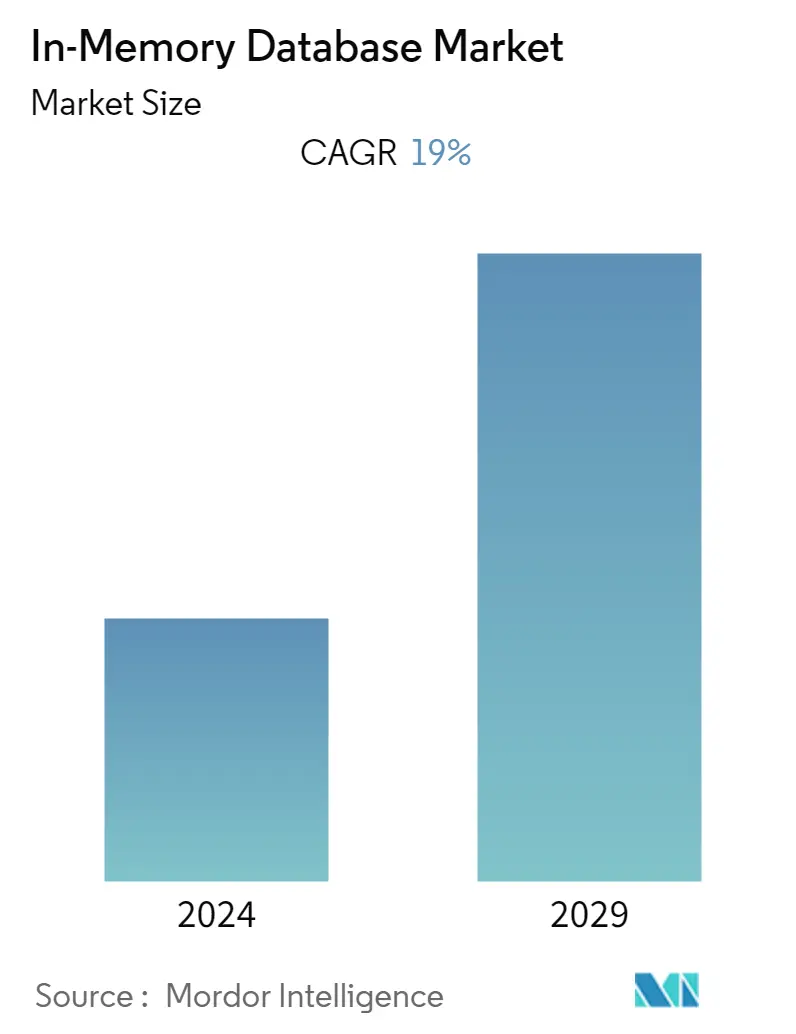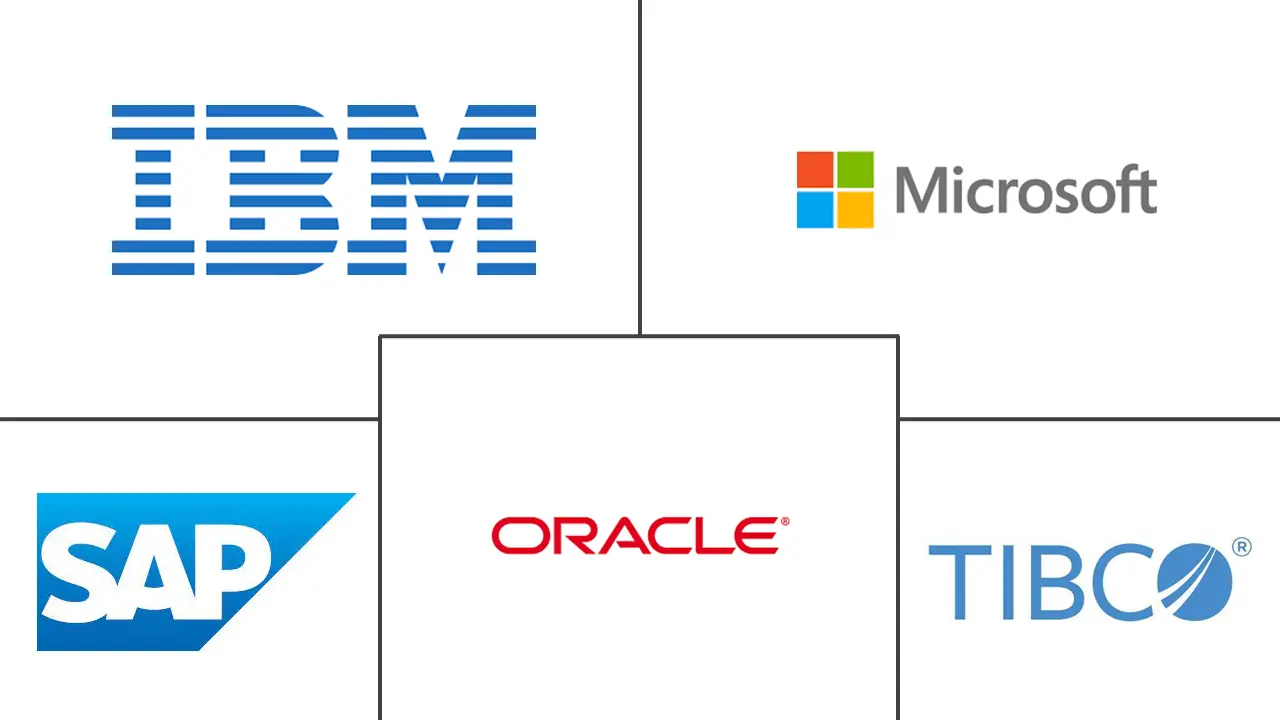Market Size of In-Memory Database Industry

| Study Period | 2019 - 2029 |
| Base Year For Estimation | 2023 |
| CAGR | 19.00 % |
| Fastest Growing Market | Asia-Pacific |
| Largest Market | North America |
| Market Concentration | High |
Major Players
*Disclaimer: Major Players sorted in no particular order |
In Memory Database Market Analysis
The in-memory database market is expected to register a CAGR of 19% over the forecast period. The in-memory database market is considered the next step after traditional databases. Although the technology has its own drawbacks, many believe that the cons will soon outweigh the pros. Indications of its expansion can be seen in the increasing adoption of it across various industry verticals.
- In-memory computing is gaining popularity worldwide as a novel means of boosting performance and processing. The market for in-memory computing is being driven by the growing use of in-memory databases and computing in corporate firms, the growing use of in-memory computing by airlines to meet SLAs, and the spread of big data to automate and improve decision-making.
- It also grows as machine learning and artificial intelligence transform the technology industry by making data processing easier and faster for corporations, banks, and other services. According to IBM, in the last year, North American AI adoption rates will have reached 25% for implemented AI and 43% for researching AI.
- The in-memory database market is being driven by many things, such as the ability to solve problems with data analytics in real time and speed up digital transformation for businesses.The data generated by these devices can provide unique data pertaining to individuals that can be leveraged to gain insights, which prove to be game changers for industries. Smartphones and various trends, like the Internet of Things, contribute to increasing data production.
- Along with other trends like AI and machine learning, these IoT devices are being used in more and more industries. Using this data in real time in in-memory databases is a crucial part of this.
- The COVID-19 outbreak significantly influenced the expansion of the in-memory database market, as the growing number of mobile phone users, expanding use of smart devices, and booming e-commerce sector gave the market attractive potential for growth. COVID-19 created issues across the social, economic, and energy sectors, as well as in medical care. This crisis has several direct and indirect consequences for all aspects of society. Meanwhile, the digital and artificial intelligence industries can provide professional help in managing and controlling the viral spread. Due to the COVID-19 pandemic, increased health awareness among people led to many physicians and health workers delivering their services via apps. This factor is expected to boost the market's growth.
In Memory Database Industry Segmentation
In-memory databases are purpose-built systems that store data largely in memory, as opposed to databases that store information on disks or SSDs. In-memory data storage is intended to provide fast reaction times by removing the requirement for disk access.
The in-memory database market is segmented by industry size (small, medium, and large), end user (BFSI, retail, logistics, and transportation, entertainment and media, healthcare, IT and telecommunication, and others), and geography (North America (US, Canada), Europe (Germany, UK, France, and Rest of Europe), Asia Pacific (India, China, Japan, and Rest of Asia-Pacific), and Rest of the World.
The market sizes and forecasts are provided in terms of value (USD million) for all the above segments.
| By Industry Type | |
| Small and Medium | |
| Large |
| By End-user Industry | |
| Telecommunication and IT | |
| BFSI | |
| Logistics and Transportation | |
| Retail | |
| Entertainment and media | |
| Healthcare | |
| Other End-user Industries |
| Geography | ||||||
| ||||||
| ||||||
| ||||||
| Rest of the World |
In-Memory Database Market Size Summary
The in-memory database market is poised for significant growth, driven by its adoption as a more advanced alternative to traditional databases. This technology is gaining traction across various industries due to its ability to enhance performance and processing speeds, particularly in sectors like telecommunications and IT. The increasing integration of in-memory databases with machine learning and artificial intelligence is further propelling market expansion, as these technologies streamline data processing for businesses, banks, and other services. The rise of big data and the Internet of Things (IoT) is also contributing to the market's growth, as real-time data analytics become crucial for decision-making and digital transformation. The COVID-19 pandemic has accelerated this trend, with the surge in mobile device usage and e-commerce providing fertile ground for in-memory database solutions.
North America leads the in-memory database market, with major players like IBM, Microsoft, Oracle, and SAP driving innovation and adoption. The region's legacy of technological advancement and the increasing use of mobile devices are key factors in its market dominance. The telecommunications industry, in particular, is experiencing a surge in demand for in-memory databases to manage the exponential growth of data and enhance security measures. The market is moderately consolidated, with strategic alliances and product launches, such as IBM's SingleStoreDB and Redis's partnership with Amazon Web Services, highlighting ongoing developments. These advancements are expected to further solidify the market's growth trajectory, as businesses increasingly recognize the benefits of real-time data availability and analytics.
In-Memory Database Market Size - Table of Contents
-
1. MARKET DYNAMICS
-
1.1 Market Overview
-
1.2 Industry Value Chain Analysis
-
1.3 Industry Attractiveness - Porter's Five Forces Analysis
-
1.3.1 Threat of New Entrants
-
1.3.2 Bargaining Power of Buyers/Consumers
-
1.3.3 Bargaining Power of Suppliers
-
1.3.4 Threat of Substitute Products
-
1.3.5 Intensity of Competitive Rivalry
-
-
1.4 Market Drivers
-
1.4.1 Decreasing Hardware Cost
-
1.4.2 Increasing Penetration Of Trends Like Big Data And IOT
-
1.4.3 Increase In The Volume Of Data Generated And Shift Of Enterprise Operations
-
-
1.5 Market Restraints
-
1.5.1 Resilience In Integration With VLDB'S
-
-
1.6 Assessment of COVID-19 Impact on the Market
-
-
2. MARKET SEGMENTATION
-
2.1 By Industry Type
-
2.1.1 Small and Medium
-
2.1.2 Large
-
-
2.2 By End-user Industry
-
2.2.1 Telecommunication and IT
-
2.2.2 BFSI
-
2.2.3 Logistics and Transportation
-
2.2.4 Retail
-
2.2.5 Entertainment and media
-
2.2.6 Healthcare
-
2.2.7 Other End-user Industries
-
-
2.3 Geography
-
2.3.1 North America
-
2.3.1.1 United States
-
2.3.1.2 Canada
-
-
2.3.2 Europe
-
2.3.2.1 United Kingdom
-
2.3.2.2 Germany
-
2.3.2.3 France
-
2.3.2.4 Rest of Europe
-
-
2.3.3 Asia-Pacific
-
2.3.3.1 China
-
2.3.3.2 Japan
-
2.3.3.3 India
-
2.3.3.4 Rest of Asia-Pacific
-
-
2.3.4 Rest of the World
-
-
In-Memory Database Market Size FAQs
What is the current In-Memory Database Market size?
The In-Memory Database Market is projected to register a CAGR of 19% during the forecast period (2024-2029)
Who are the key players in In-Memory Database Market?
IBM Corporation, Microsoft Corporation, Oracle Corporation, SAP SE and TIBCO Software Inc. are the major companies operating in the In-Memory Database Market.

